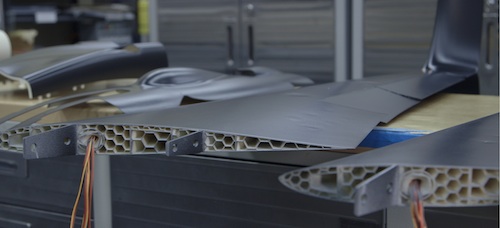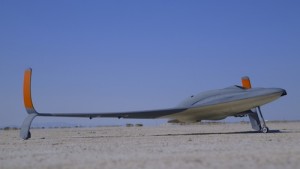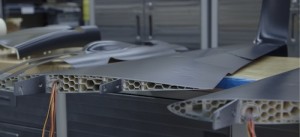3D Printing Shortens Flight Plan for UAV

Aurora’s UAV demonstrates the Stratasys FDM-based 3D printing solution’s ability to build a completely enclosed hollow. Image Courtesy of Stratasys
November 12, 2015
There's 3D printing and then there's 3D printing on a grand scale. Stratasys, in partnership with Aurora Flight Sciences, recently launched what they claim is the largest, fastest and most complex 3D printed unmanned aerial vehicle (UAV) built to date.
Previewed at the Dubai Airshow, this high-speed demonstration aircraft has a 3-meter (9-ft.) wingspan and weighs in at only 15 kilograms (or the equivalent of 33 lbs.). The design team tapped Stratasys' Fused Deposition Modeling (FDM) 3D printing technology to produce about 80% of the UAV as opposed to using traditional manufacturing technologies.
 Aurora Flight Sciences’ high-speed UAV is 80% 3D printed with Stratasys additive manufacturing solutions. Image Courtesy of Stratasys
Aurora Flight Sciences’ high-speed UAV is 80% 3D printed with Stratasys additive manufacturing solutions. Image Courtesy of StratasysThe project, designed as a technology demonstration, is important because it showcases the possibilities for 3D printing in the aerospace industry, specifically as a way to accelerate the schedule from design to building to flight, says Dan Campbell, aerospace research engineer at Aurora Flight Sciences, a leading manufacturer of UAVs and aerospace vehicles that does a lot of work for the Department of Defense. In addition, it also proves how widespread use of 3D printing can reduce the entire development-to-production cycle for mission-specific aircraft by as much as 50%.
“The cost of doing a one-off aircraft with additive manufacturing processes is significantly less than using traditional manufacturing processes,” Campbell said. That's not to say that you can't produce a mission-specific or custom part with traditional manufacturing techniques, but the process is much more involved and costly. “You end up having to invest in tooling, and the manufacturing process gets drawn out because of that and gets more expensive,” he explains. “I wouldn't say AM is the enabler, but it does allow us, from a cost and schedule standpoint, to customize that much more.”
Customization is particularly important in the aerospace industry, where the design process is all about reducing weight and drag. The combination of 3D printing and topology optimization techniques enabled the Aurora team to hone in on the organic shapes and structures that would give the UAV top performance, ultimately clocking in at speeds in excess of 150mph.
 Aurora’s UAV demonstrates the Stratasys FDM-based 3D printing solution’s ability to build a completely enclosed hollow. Image Courtesy of Stratasys
Aurora’s UAV demonstrates the Stratasys FDM-based 3D printing solution’s ability to build a completely enclosed hollow. Image Courtesy of StratasysWhile Stratasys FDM technology was used to create the bulk of the core lightweight structural components, the UAV was an exercise in multi-material 3D printing. The fuel tank, which needed to hold fluid, was produced in nylon using laser sintering technology, while the thrust vectoring exhaust nozzle was 3D printed in metal (Inconel material) to ensure it could withstand the extreme heat at the engine nozzle.
The collaborative effort was facilitated by use of GrabCAD to conduct weekly design reviews, manage models and do real-time tracking of attributes such as weight and how various portions of the airplane were coming along. Campbell says some parts of the craft took 20 iterations to get right, but the collaborative process didn't slow down delivery because it was simply a matter of updating a digital inventory and replacing a CAD file.
To hear Campbell and his colleagues talk in greater detail about the 3D printed UAV project, check out the video at the top of the post.
Subscribe to our FREE magazine, FREE email newsletters or both!
About the Author
Beth Stackpole is a contributing editor to Digital Engineering. Send e-mail about this article to [email protected].
Follow DE





